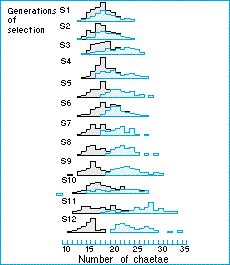Natural selection and variation - What are the types of natural selection?

An example of disruptive selection: bristles on fruitflies
In nature, sexual dimorphism is probably a common example of disruptive selection; but here we shall use an experiment by Thoday and Gibson on the Drosophila melangaster fruitfly as an example.
Thoday and Gibson bred from fruitflies with high, or low, numbers of bristles on a certain region of the body; individuals with intermediate numbers of bristles were prevented from breeding. As the graph shows, after 12 generations of this disruptive selection, the population had noticeably diverged. Disruptive selection is of particular theoretical interest, both because it can increase the genetic diversity of a population and promote speciation.
Figure: experimental disruptive selection on sternopleural bristle number in fruitflies. Individuals with many or few bristles were allowed to breed, those with intermediate numbers were not; and the population rapidly diverged. After Thoday & Gibson (1962).
| Next |



